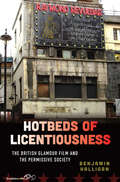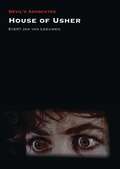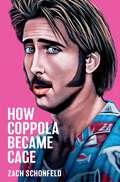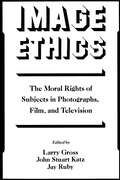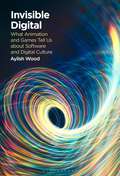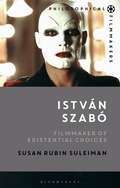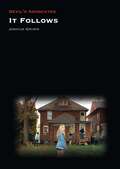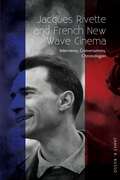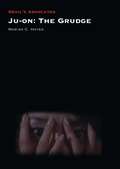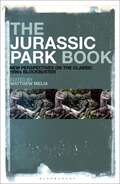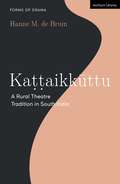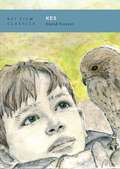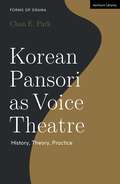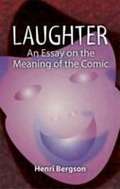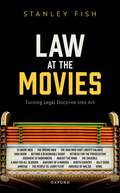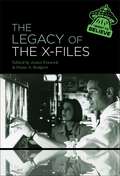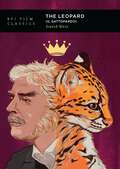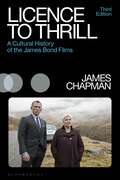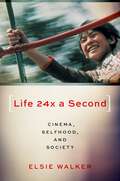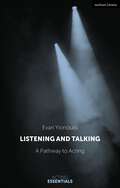- Table View
- List View
Hotbeds of Licentiousness: The British Glamour Film and the Permissive Society
by Benjamin HalliganHotbeds of Licentiousness is the first substantial critical engagement with British pornography on film across the 1970s, including the “Summer of Love,” the rise and fall of the Permissive Society, the arrival of Margaret Thatcher, and beyond. By focusing on a series of colorful filmmakers whose work, while omnipresent during the 1970s, now remains critically ignored, author Benjamin Halligan discusses pornography in terms of lifestyle aspirations and opportunities which point to radical changes in British society. In this way, pornography is approached as a crucial optic with which to consider recent cultural and social history.
House of Usher (Devil's Advocates)
by Evert van LeeuwenDespite being the product of Roger Corman’s AIP exploitation studio, House of Usher enjoys a high standing. But while the impact and cult status of Corman’s Edgar Allan Poe cycle is often discussed in histories of gothic, horror, and exploitation cinema, no extended analysis and critical discussion has been published to date that explores specifically the aesthetic appeal of House of Usher. This Devil’s Advocate provides a complete study of the aesthetic appeal of Corman’s influential first Poe picture.Evert van Leeuwen explores the underlying narrative structure borrowed from Poe’s original story and shows how closely Richard Matheson’s script followed Poe’s theory of short fiction. He goes on to explore the formal techniques of allegory and symbolism employed to represent the house as a monster before focusing on Corman’s imagery, showing how the use of specific camera angles, lenses, colors, and sound effects create and sustain the simultaneously morbid and beautiful atmosphere of gothic decay. Finally, he situates horror icon Vincent Price’s performance as Roderick Usher in the context of the nineteenth-century Romantic misfit and the postwar countercultural antihero, two closely related cultural identities.
How Coppola Became Cage
by Zach SchonfeldAn in-depth look at one of the film industry's most audacious working actors In 1982, a gangly teenager named Nicolas Coppola made his film debut and changed his name to Nicolas Cage, determined to distance himself from his famous family. Once he achieved stardom as the rebel hunk of 1983's Valley Girl, Cage began a career defined by unorthodox risks and left turns that put him at odds with the stars of the Brat Pack era. How Coppola Became Cage takes readers behind the scenes of the beloved cult movies that transformed this unknown actor into an eccentric and uncompromising screen icon with a wild-eyed gift for portraying weirdos, outsiders, criminals-and even a romantic capable of seducing Cher. Author Zach Schonfeld traces Cage's rise through the world of independent cinema and chronicles the stories behind his career-making early performances, from the method masochism of Birdy to the operatic torment of Moonstruck and abrasive expressionism of Vampire's Kiss, culminating with the astonishing pathos of Leaving Las Vegas. Drawing on more than 100 new interviews with Cage's key collaborators--including David Lynch, Martha Coolidge, John Patrick Shanley, and Mike Figgis--How Coppola Became Cage offers a revealing portrait of Cage's wildly intense devotion to his performances behind the scenes and his creative self-discovery as he drew on influences as far-flung as silent cinema and German Expressionism. These were all crucial ingredients in the creation of a singular acting style that rejects the limits of realism. Brimming with previously untold stories and insights, How Coppola Became Cage both revels in and demystifies Cage's onscreen eccentricities. No other modern actor has explored such profound creative extremes while bending the boundaries of good taste. Here is the origin story of an actor who truly is wild at heart and weird on top.
I Walked With a Zombie (Devil's Advocates)
by Clive DawsonI Walked with a Zombie (1943), Val Lewton's second feature for RKO Radio Pictures, was described by critic Robin Wood as 'perhaps the most delicate poetic fantasy in the American Cinema.' Following immediately in the wake of the groundbreaking Cat People (1942), Zombie pioneered an even more radical narrative approach yet proved to be the critical and commercial equal of its predecessor, cementing the reputation of both Lewton and his director, Jacques Tourneur. Despite the lurid, studio-imposed title, I Walked with a Zombie is a subtle and ambiguous visual poem that advanced a daring condemnation of slavery and colonialism at a time when such themes were being actively suppressed by government censors. Clive Dawson charts the complex development and production of the project, essential to understanding the concerns of the filmmakers in the context of wartime Hollywood, then analyses the film in detail, referencing a broad range of academic studies of the audio-visual text and distilling new insight into its layers of meaning. Finally, he explores the film's reception, and the influence it exerted on the horror genre and beyond. Extensive primary research has uncovered a wealth of previously unpublished new material that solves many unanswered questions and dispels various myths about this utterly unique film.
Image Ethics: The Moral Rights Of Subjects In Photographs, Film, And Television
by Larry Gross John Stuart Katz Jay RubyInvisible Digital: What Animation and Games Tell Us about Software and Digital Culture
by Aylish WoodInvisible Digital helps us makes sense of something we cannot see by presenting an innovative approach to digital images and digital culture. At its heart is a novel method for exploring software used in the creation of moving images as markers of converging cultural, organizational and technological influences. The three main case studies of Invisible Digital are the animated feature Moana (2016) and the computer games No Man's Sky (2016) and Everything (2017). All three were created using procedural techniques: simulation software for Moana, and procedural content generation for No Man's Sky and Everything. Production culture disclosures associated with procedural techniques often emphasize the influences of automated systems and their algorithms, making them ideal for a study that interrogates digital processes. The approach of Invisible Digital is informed by relational theories and the concept of entanglement based on materialist perspectives, combined with insights from work that more explicitly interrogates algorithms and algorithmic culture. Aylish Wood employs the notion of assemblages to introduce the concept of material-cultural narratives. Using this conceptual framework, she draws out material-cultural narratives for each case study to demonstrate what they reveal about software and digital culture. These analyses of software provide a widely applicable method through which moving image studies can contribute more fully to the wider and growing debates about algorithmic culture.
István Szabó: Filmmaker of Existential Choices (Philosophical Filmmakers)
by Susan Rubin SuleimanIstván Szabó is one of the few Hungarian filmmakers to have earned a major international reputation over the past half century. This thoughtful and original book is the first examination of Szabó's contribution to contemporary thought, engaging the troubled history of Europe in the 20th and 21st centuries. István Szabó's importance as a filmmaker lies not only in his attention to film's formal elements but in his deep and ongoing engagement with some of the most urgent ethical and existential questions of our time. With detailed analyses of István Szabó's major films, from his 1960s works to his Academy Award for Best Foreign Film winner, Mephisto, and on through Szabó's last film in 2020, Final Report, Susan Rubin Suleiman focuses on four important questions pertaining to existential choice: to leave home or to stay in a communist country? To collaborate or not with an authoritarian regime? To affirm or to deny one's Jewishness in the face of antisemitism? To seek or to give up on community in the face of individual or national conflicts? Above all, Suleiman addresses the single most important philosophical question that haunts Szabó's work, as it does that of many other Central European intellectuals and filmmakers of our time. That is, how do individuals attempt, through the life choices they make or that are foisted on them, to create a viable self in extreme historical situations over which they have no control?
IT Chapters One and Two (Devil's Advocates)
by Alissa BurgerDrawing on critical analysis of film, the horror genre, the Gothic, and Stephen King scholarship, this book considers Andy Muschietti’s IT Chapter One (2017) and IT Chapter Two (2019) on multiple levels: as film (both as individual films and through their interconnected narrative), as adaptation, and as a barometer of the horror film’s popularity among fans. Key points of consideration include the significance of the fictional town of Derry as a traditionally Gothic “bad place,” the role of 1980s nostalgia in these two films, the complex navigation of memory and trauma, gender representation, queer representation, and the return of the repressed. The terrifying figure of Pennywise the clown is central to this analysis, including consideration of performance, costuming, and significance within the larger landscape of the “scary clown” popular culture trope, and through comparison to Tim Curry’s iconic performance in Tommy Lee Wallace’s 1990 miniseries. This Devil's Advocate contextualizes Muschietti’s films within the larger landscape of King’s literary and popular culture influence, as well as the debate surrounding “elevated” horror and the “horror boom” of the late 2010s.
It Follows (Devil's Advocates)
by Josh GrimmAmid a recent resurgence in horror films, David Robert Mitchell’s It Follows stands out as a particularly bold entry, a horror fan’s dream come true that sparked a renewed creativity. Pulling a robust 97% on Rotten Tomatoes, It Follows was hailed as a “teen movie you’ve never seen before,” a “creepy, mesmerizing exercise in minimalist horror,” “the best horror film in years,” and simply, “so damn good.” Mitchell uses a variety of approaches to reinvent genre bromides while simultaneously embracing and challenging tropes that audiences and filmmakers rely on a little too heavily. It Follows is one of the best because it is one of the most unique. In this Devil’s Advocate, Joshua Grimm focuses on how this film helped reinvent the rules of a horror movie, particularly along the lines of genre, style, sex, and gender.
Jacques Rivette and French New Wave Cinema: Interviews, Conversations, Chronologies
by James R RussoThis first comprehensive English collection of the interviews of Jacques Rivette (19282016) documents his career through chronology, filmography, bibliography, and image stills. A comprehensive introduction places this work in the wider context of twentieth-century social change. Rivettes films, like many of the works of the French New Wave, seem to have avoided the aging process entirely, remaining as playful, fresh, and quietly spectacular as the day they were made. Indeed, his body of work may be the most impressive of the French New Wave. Celine and Julie Go Boating (1974) has been recognized as possibly the best film to emerge from the post-New Wave era, even as Paris Belongs to Us (1961) is one of the best pictures to emerge from the New Wave itself. Rivette was hardly the most prolific director, however, and the length of his films has often counted against him. Nonetheless, his clinical, self-reflexive essays in film form reveal him as a cinematic purist whose commitment to the celluloid muse hardly diminished from the heady days of the early 1950s to the end of his career in 2009. Beyond inspiring the New Wave movement and continuing to reflect, and reflect on, its central tenets, Rivettes enduring contribution to the history of film is unquestionably evident in his sensitive treatment of the histories and destinies of women, especially through strong roles for actresses. During the six decades of his career, nonetheless, he struck a subtle balance not only between female and male characters, but also between political and personal obsession, between myth and fiction, between theater and cinema, in films that, in addition to having influenced such contemporary filmmakers as Claire Denis, Jim Jarmusch, Olivier Assayas, and David Lynch, continue to redefine the art of cinema around the world.
Ju-On: The Grudge (Devil's Advocates)
by Marisa HayesTakashi Shimizu's Ju-on franchise was a principal instigator in the rise of contemporary Japanese horror and its international popularity at the turn of the millennium. Following the success of Hideo Nakata's Ringu (1998), the first cinematic release of Ju-on: The Grudge in 2002 crystallized Japanese horror's rise to prominence and outlined the new decade's thematic interest in supernatural technology and fear of contagions, while skillfully navigating domestic social concerns, such as Japan's growing elderly population and domestic violence.This Devil's Advocate explores the production roots of Ju-on The Grudge, followed by a critical reading of the film that highlights its essential themes and motifs, in addition to a section on cultural influences, before concluding with a section on Shimizu's continued involvement with the Ju-on franchise and its ongoing legacy. The book serves as an excellent primer for readers without prior knowledge of Japanese horror or the Ju-on film cycle, while providing fresh perspectives on the film that makes it equally appealing to J-horror aficionados.
The Jurassic Park Book: New Perspectives on the Classic 1990s Blockbuster
The definitive 1990s blockbuster, Steven Spielberg's Jurassic Park met with almost universal critical and popular acclaim, broke new ground with its CGI recreation of dinosaurs, and started one of the most profitable of all movie franchises. To mark the film's 30th anniversary, this exciting illustrated collection of new essays interrogates the Jurassic Park phenomenon from a diverse range of critical, historical, and theoretical angles. The primary focus is on Jurassic Park itself but there is also discussion of the franchise and its numerous spin-offs.As well as leading international scholars of film studies and history, contributors include experts in special effects, science on screen, fan studies, and palaeontology. Comprehensive, up to date, and accessible, The Jurassic Park Book appeals not only to students and scholars of Hollywood and contemporary culture, but also to the global audience of fans of the greatest of all dinosaur movies.
Kattaikkuttu: A Rural Theatre Tradition in South India (Forms of Drama)
by Hanne M. BruinThis is the first book to offer a clear introduction to Kattaikkuttu (or Terukkuttu), a vibrant, vocal and physical outdoor Tamil theatre tradition from India. It describes the theatre's characteristic heroic nature as expressed through its principal, male kattai characters, explores its history, social status and ritual context, and examines the production of all-night plays. After placing Kattaikkuttu in the wider, competitive context of the performing arts in India, Hanne M. de Bruin introduces readers to some of the debates about the form and provides an overview of the different elements that make up a Kattaikkuttu performance. It considers its performance spaces and the way the form has changed, such as its transition towards an independent and more professional theatre genre, as well as the opening up of the form to different castes and to women. It covers the production and frameworks of all-night performances, uses the Mahabharata play Karna Moksam as a case study and examines recent changes in the Kattaikkuttu repertory. In addition, the book looks in more detail at the role of the performer, including the training of a Kattaikkuttu novice, the performance score of actor-singers that underlie a specific role or vesam, and a seasoned performer's agency in interpreting well-known roles. Finally, the study turns to recent innovations, in particular the creation of new work and the Kattaikkuttu Gurukulam.
Kes (BFI Film Classics)
by David ForrestKen Loach's 1969 drama Kes, considered one of the finest examples of British social realism, tells the story of Billy, a working class boy who finds escape and meaning when he takes a fledgling kestrel from its nest.David Forrest's study of the film examines the genesis of the original novel, Barry Hines' A Kestrel for a Knave (1968), the eventual collaboration that brought it to the screen, and the film's funding and production processes. He provides an in depth analysis of key scenes and draws on archival sources to shed new light on the film's most celebrated moments. He goes on to consider the film's lasting legacy, having influenced films like Ratcatcher (1999) and This is England (2006), both in terms of its contribution to film history and as a document of political and cultural value. He makes a case for the film's renewed relevance in our present era of systemic economic (and regional) inequality, alienated labour, increasingly narrow educational systems, toxic masculinity, and ecological crisis. Kes endures, he argues, because it points towards the possibility for emancipation and fulfilment through a more responsive and nurturing approach to education, a more delicate and symbiotic relationship with landscape and the non-human, and an emotional articulacy and sensitivity shorn of the rigid expectations of gender.
Korean Pansori as Voice Theatre: History, Theory, Practice (Forms of Drama)
by Chan E. ParkThis book introduces readers to the historical, performative, and cultural context of pansori, a traditional Korean oral story-singing art. Written by a scholar-practitioner of the form, this study is structured in three parts and begins by introducing readers to the technical, aesthetic, and theoretical components of pansori, as well as the synthesis of vocal and percussive elements that stage the narrative. It moves on to reflect on the historical contexts of pansori, alongside Korea's transformation from Joseon monarchy to modern statehood. It argues that with colonial annexation came modernist influences that Korean dramatists and audiences used to create new genres of performance, using the common thread of pansori. The book's third part explores the interplay of preservation and innovation, beginning in the post-war period and continuing with developments in the 20th and 21st centuries that coincide with Korea's imprint on cultural globalization. Along with Korea's growth as a world economic center, a growing enthusiasm for Korean culture around the world has increased the transmission and visibility of pansori. This study argues that tradition and innovation are not as divergent as they are sometimes imagined to be and that tradition is the force that enables innovation. Drawing on Chan E. Park's ethnographic work and performance practice, this book interweaves expert knowledge of both the textual and performative aspects of pansori, rendering legible this dramatic tradition.
Kubrick and Control: Authority, Order and Independence in the Films and Working Life of Stanley Kubrick (Stanley Kubrick Studies)
by Jeremy CarrKubrick and Control is an examination of authority, order, and independence in the films directed by Stanley Kubrick, as well as in his personal life and working habits. This study explores the ways in which these central preoccupations develop and reformulate through the course of Kubrick's career, as he moved from genre to genre and shifted stories, locations, time periods, scope, and technical facilities. Separating the productions in accordance to their wider filmic classifications, the individual chapters examine a variety of productions, allowing for a categorical as well as a developmental approach to the works. In addition, following concurrently with each individual film discussed, details about Kubrick's life and evolving directorial practice are recounted in relation to these same concerns. In studying the stylistic and narrative features of his work, examples illustrate how Kubrick took these themes and applied them consistently yet with significant variation, manifest in relation to mise-en-scène construction (how Kubrick composed his images); characterization (individuals establishing, exerting, seeking, and/or abusing their authority); narrative (stories about characters and situations dependent upon order and control); and the actual filmmaking processes of the director (Kubrick was both praised and damned for his authorial management and obsession with order and perfection).
Laughter: An Essay on the Meaning of the Comic
by Henri BergsonIn this great philosophical essay, Henri Bergson explores why people laugh and what laughter means. Written at the turn of the twentieth century, Laughter explores what it is in language that makes a joke funny and what it is in us that makes us laugh. One of the functions of humor, according to Bergson, is to help us retain our humanity during an age of mechanization. Like other philosophers, novelists, poets, and humorists of his era, Bergson was concerned with the duality of man and machine. His belief in life as a vital impulse, indefinable by reason alone, informs his perception of comedy as the relief we experience upon distancing ourselves from the mechanistic and materialistic. "A situation is always comic," Bergson notes, "if it participates simultaneously in two series of events which are absolutely independent of each other, and if it can be interpreted in two quite different meanings. " The philosopher's thought-provoking insights (e. g. , "It seems that laughter needs an echo. Our laughter is always the laughter of a group. ") keep this work ever-relevant as a thesis on the principles of humor.
Law at the Movies: Making Change in the Networked Public Sphere (Law and Literature)
by Thomas J BillardTransgender rights have emerged as an important topic of everyday conversation across the country in recent years and become, in many ways, the flashpoint du jour of the American culture wars. During the Trump presidency in particular, transgender people were thrust onto the center stage of US politics. Faced with unrelenting hostility and an increasingly complicated media system, transgender activists crafted new communication strategies to fight for their equality, stall attempts to undermine their rights, and win the support of large swathes of the public. In Voices for Transgender Equality, Thomas J Billard offers an insider's view into transgender activism during the first two years of the Trump administration. Drawing on extensive on-the-ground observation at the National Center for Transgender Equality, Billard shows how these activists developed an unlikely blend of online and offline strategies to saturate a diverse ecology of national news outlets, local and community media outlets across the country, and both public and private conversations across multiple social media platforms with voices in support of their cause. Moreover, these activists navigated the complex flows of information and ideas among these different domains of the communication system as they worked to shape the national conversation on transgender rights. As Billard argues, this movement occurred at a very particular time in the development of the media system, with "new" media shaping the movement in important ways that are both generalizable to other social movements and unique to transgender activism. Including rich storytelling and insightful analysis, Voices for Transgender Equality makes a compelling case of what it takes to make social and political change in a world transformed by digital media. Along the way, Billard provides key insights into the new business-as-usual of mediated politics and valuable lessons for more effective activism.
Law at the Movies: Turning Legal Doctrine into Art (Law and Literature)
by Prof Stanley FishThis book asks "How can legal doctrine be turned into filmic art?" By "legal doctrine" Stanley Fish does not mean the sonorous abstractions that usually accompany the self-presentation of law--Justice, Equity, Equality, Liberty, Autonomy, and the like. Rather he has in mind the specific rules and procedures invoked and analyzed by courts on the way to declaring a decision--lawyer/client confidentiality, the distinction between interdicted violence and the violence performed by the legal system, the interplay of positive law and laws rooted in morality, the difference between civilian law and military law, the death penalty, the admissibility of different forms of evidence. In the movies he discusses, these and other points of doctrine and procedure do not serve as a background, occasionally visited, to the substantive issues that drive the plot and provide the characters with choices; they declare the plot, and character is formed and tested in relationship to their demands. Apparently technical matters are pressed until they occupy both foreground and background and become the movie's true subject. If large, abstract concepts emerge, they emerge at the back end of doctrine and are, in effect, produced by doctrine. These are not law-themed movies; they are movies about the unfolding of legal process.
The Legacy of The X-Files
The Legacy of The X-Files examines the content and production of the show, its reception, its use of legend and folklore, its contemporary resonance in politics and society of the 21st century, and its impact and legacy on film, television, the Internet and beyond. Having converged with the early widespread use of the Internet, The X-Files became a cultural touchstone of the 1990s, transforming from a cult TV show into a pop cultural phenomenon by the end of the decade. To celebrate the 30th anniversary of The X-Files, this collection examines the content and production of the show, its reception, its use of legend and folklore, its contemporary resonance in politics and society of the 21st century, and its impact and legacy on film, television, the Internet and beyond. The series' themes of government mistrust, conspiracy, folklore, UFOlogy, and faith are dissected and applied to how the show spirituality resonated with post-Cold War Western society.Contributors to this collection discuss the wide-ranging impact of the television show in popular culture, from Mulder and Scully 'shippers' to the show's slogan entering the contemporary lexicon. The Legacy of The X-Files serves as an all-encompassing, multi-disciplinary, contemporary account of The X-Files, reflecting upon critical, historical, political, and social contexts, and featuring an in-depth and comprehensive introduction making it a vital work for researchers and students alike.
The Leopard (BFI Film Classics)
by David WeirLuchino Visconti's The Leopard (Il Gattopardo, 1963) tells the story of an aristocratic Sicilian family adjusting to the realities of political and commercial modernity after the unification Italy during the Risorgimento.The film, starring Claudia Cardinale, Burt Lancaster and Alain Delon, met with success upon its initial release, winning the Palme d'Or at Cannes and having a successful theatrical run in Europe. Despite this, however, it did not do well with English-speaking audiences, and eventually even fell out of favour with Italian audiences, who took issue with the way Risorgimento history was represented. David Weir's study of the film seeks to understand the film's paradoxical place in Italian film history. He argues that Visconti's use of artifice, narrative and history, all aspects that came to be criticised, were in fact, essential to his cinematic art, and can all be understood as strengths of the film. Providing a scene-by-scene analysis of the film, as well as illuminating its relationship to the Lampedusa novel from which it was adapted, Weir suggests that Visconti's film goes beyond mere adaptation, using the form of the novel for cinematic purposes and making The Leopard a cinematic novel in its own right. He goes on to situate the film within Visconti's career, questioning whether the uneven reception of the film reflects the paradox of Visconti's social status as a Marxist aristocrat and his position as an auteur director whose films borrowed heavily from the decadent tradition, while at the same time professing allegiance to the Italian Communist Party.
Licence to Thrill: A Cultural History of the James Bond Films (Cinema and Society)
by Prof James ChapmanIn this new edition of Licence To Thrill, James Chapman builds upon the success of his classic work, regarded as the definitive scholarly study of the history of the James Bond film series from the first picture, Dr No (1962), to the present. He considers the origins of the films in the spy thrillers of Ian Fleming and examines the production histories of the films in the contexts of the British and international film industries.This edition includes a new introduction and chapters on Quantum of Solace (2008), Skyfall (2012), Spectre (2015) and No Time to Die (2021). Chapman explores how the films have changed over time in response to developments in the wider film culture and society at large. He charts the ever-evolving Bond formula, analysing the films' representations of nationhood, class, and gender in a constantly shifting cinematic and ideological landscape.
Life 24x a Second: Cinema, Selfhood, and Society
by Elsie WalkerLife 24x a Second highlights the life-sustaining and life-affirming power of cinema. Author Elsie Walker pays particular attention to pedagogical practice and students' reflections on what the study of cinema has given to their lives. This book provides multiple perspectives on cinema that matters for the deepest personal and social reasons-from films that represent psychological healing in the face of individual losses to films that represent humanitarian hope in the face of global crises. Ultimately, Walker shows how cinema that moves us emotionally can move us toward a better world. Life 24x a Second makes the case for cinema as a life force in uplifting and widely relatable ways. Walker zeroes in on films that offer hope in relation to the Black Lives Matter movement (Imitation of Life, 1959, and BlacKkKlansman, 2018); contemporary feminism (Nobody Knows, 2004); rite-of-passage experiences of mortality and mourning (Ikiru, 1952, and A Star Is Born, 2018), and first-love grief (Call Me by Your Name, 2017, and Portrait of a Lady on Fire, 2019). Life 24x a Second invites readers to reflect on their own unique film-to-person encounters along with connecting them to others who love cinematic lessons for living well.
Listening and Talking: A Pathway to Acting (Acting Essentials)
by Ms Evan YionoulisListening and Talking: A Pathway to Acting provides undergraduate acting students with a clear, achievable, step-by-step way to approach the work of playing a role. The text is supplemented by exclusive video material to take the actor from their first encounter with the text through rehearsals with fellow actors and into performance. Drawing from the author's twenty years' experience of teaching at the Yale School of Drama, this book, which is influenced, too, by the work of legendary teachers such as Konstantin Stanislavski and Uta Hagen, presents a thorough examination of key aspects of the actor's technique (for example, listening, playing an action and pursuing an objective). Throughout, it includes exercises and process points through which students can put into practice the key lessons from each chapter.The practices laid out in this book form a holistic curriculum that not only ensures measurable results over a semester- or year-long course, but also sets in motion an internal process that will serve the student over their life as an artist.
